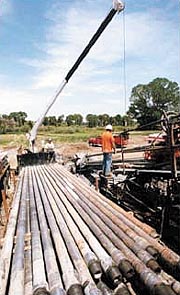
Each drill pipe manufacturer has different specifications. The “Drilling Data Handbook” (Gabolde and Nguyen, 1999) provides guidelines keyed to grade of steel for tubing sizes and associated tensional and torsional load capacities as well as bend radii. In addition to tubing load capacities, other important considerations include: 1) diameter, wall thickness and length; 2) manufacturing process (e.g., inertia welded vs. forged); 3) minimum tool joint makeup torque and maximum tool joint torque capacity; and 4) thread type as it relates to life of the pipe, ease of connection and allowable bend radius. Once the proper drill pipe has been selected for an application, sound practices must be followed to ensure long life and reduce risk of downhole failure.
The first consideration is not to bend sharper than the minimum bend radius of the drill pipe. This can be achieved through pre-planning the bore profile, including entry and exit angles, bend radius and setback distances. The bend radius can also be exceeded by over-steering or deflecting from the intended bore path. Therefore, it is imperative to periodically change the order of the lead drill pipe (i.e. move the lead pipe to the end of the string, or other pipe rotation procedures) to obtain maximum drill string life. Any individual drill pipes that are identified as being bent or damaged should be immediately taken out of service. The entire drill string should be periodically inspected. Specialty drill pipe inspection companies can provide this service, if desired.
Bending the drill pipe can also occur as a result of over thrusting with too much exposed drill pipe in the drill rig or above ground in front of the rig. To avoid the first effect, at least half of each added drill pipe should be rotated into the ground before steering. To mitigate the second effect, the distance between the leading edge of the rig and the point where the drill pipe enters the ground should be as short as possible. The operator should be aware of the ground conditions and control drilling and thrust to avoid pipe damage. Excessive thrusting/pulling forces may loosen the anchoring system and cause the rig to move out of alignment (fore and aft and/or transverse) with the borehole. This exerts bending on the drill string and also causes difficulty in aligning tool joint connections whenever drill pipe is added to or removed from the drill string.
Tool joint alignment will be a problem from the very beginning if the bore is not started with a straight drill segment of one length of drill pipe. The drill head must also be prevented from deflecting or “walking” out of alignment as it enters the ground. Excavation of a small starting pit at the entry point is a key factor here. For slant-faced drilling systems, good practice also includes: (1) orientating to the 6 o'clock steering position, (2) slow, controlled entry into the ground for at least 2-3 feet without rotation, (3) preventing entry misalignment from (a) weight droop by holding the drill head up with a backhoe or (b) ride-up over stratified soil by holding the drill down with a backhoe bucket.
The operator should avoid stalling the pipe rotation to minimize stress damage resulting from shock-loading. Stalling can cause the pipe itself to corkscrew or the tool joints to become over-torqued and difficult to break out. Stalling can also be caused by using bits or reamers that are in poor condition or not suited for the soil formation. Bits and reamers should be routinely checked to ensure that they are in good condition and serviced or replaced if necessary. If stalling occurs on the pullback, the direction of travel should be reversed just enough to regain rotation. Pushing back too far could damage the product or the swivel/pulling assembly.
Additionally, bits and reamers should be compatible with the drill pipe used and the ground conditions encountered. For example, a bit that is too large for the drill pipe and ground conditions can result in excessive steering bends and stresses or buckling of the drill pipe in the bore. A reamer that is too large will result in excessive torque and pullback loads. It is often advantageous (and more productive) to use multiple reaming passes to reach the final bore size. A drill rig that is too large for the drill pipe can also apply too much torque. The drill pipe and machine torque capacities should be compatible.
Preconditioning (or breaking in) of new tool joints promotes long service life. This involves applying the recommended tool joint compound to all shoulder and thread surfaces of the box and pin, connecting the two parts together, torquing them, separating them, then repeating the process. Preconditioning smoothes irregularities on the surfaces of the thread to reduce the tendency of the threaded joints to bond together when connected. It is important to clean and lubricate the tool joint threads before each preconditioning replication. This procedure extends thread life and avoids galling from contamination in the threads or pipe grease. Tool joints should be connected and disconnected slowly to avoid galling or cross-threading. Rotation should be timed with the carriage travel speed slowly and gently. Drill pipe should be stored in pipe racks, on blocks or on spacers to avoid contact with the ground. Threaded ends of loose drill pipe should always be protected with clean end-caps. It is important to avoid dropping the joint on the pin end or dropping something onto the joint. Scarring of the shoulder can cause leaks, premature joint failure and damage to mating surfaces.
Drill pipe should be closely monitored for damage caused by worn breakout dies. Dies for breakout wrenches should be frequently cleaned and always replaced if slipping occurs. It is imperative that the dies grab the drill pipe only on the collars of the tool joint and not on the tube or the threads.
ND


Report Abusive Comment